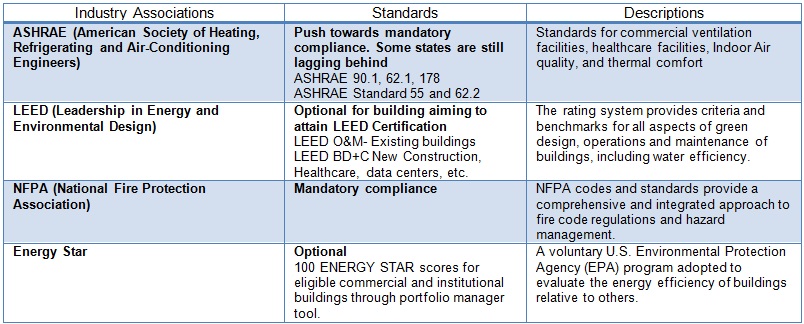September 2016 — Compliance to building codes are a given as the need for efficient heating, ventilation, fire safety and security in North American buildings and facilities is very critical. It is worthwhile to go beyond code requirements and efforts to exceed codes compliance to add value to a facility’s operations. Unwillingness to understand and comply with codes can have debilitating effects on any facility or organization. As a result, pressing noncompliance issues are motivating both FMs and manufacturers to adopt and offer energy efficient solutions respectively. FMs can employ manufacturers (Honeywell, Johnson Controls, Inc., Siemens and Trane and many others) to conduct energy audits, perform building retrofits and energy savings solutions for new and retrofit projects by inspecting the equipment that are ideally required to be in compliance with energy regulations, standards and guidelines.
Examples of a few crucial North American building standards and codes are stated below which have encouraged FMs to adopt and understand the critical adherence to these standards.
National codes and standards are constantly being modified to reflect the demand for greener codes by local officials, legislation and professional associations. For example, some states in the US are currently following 2010/2013 version of ASHRAE 90.1; however, efficiency ratings in ASHRAE 90.1 are expected to be added to the 2016 version and then retroactive as an addendum to the 2013 version in order to include more stringent ventilation specification for any facility[1]. Such revisions will represent future building standards for the nation.
Myriad sectors of building and facility industry such as building automation, HVAC, fire safety and energy management system are highly driven by North American standards and building codes. According to Frost & Sullivan, ongoing operating costs represent 50 percent to 80 percent of a building’s total life cycle costs over an estimated 40-year life span. Therefore, even a modest reduction in lifetime operating costs can enhance a building’s asset value. Additionally, fluctuating energy prices have driven facility owners to focus on energy conservation and move toward greener building practices. Due to their commitment to create more sustainable and efficient buildings, facility owners must ensure that their equipment is properly maintained, monitored and are in compliance with standards and regulatory codes so that an overall facility can achieve a significant reduction in operational costs. An example of well-established green initiative is the Chicago Center for Green Technology. The initiative focuses on green architecture by implementing the Green Permit Program to offer an expedited permit process and the possibility of reducing fees for green projects and create more energy-efficient facilities across the regions. Currently, Chicago has the most LEED-certified projects in the U.S. with 295[2].
In Canada, with the election of Prime Minister Justin Trudeau’s Liberal government, the clean energy landscape is certain to change. A federal infrastructure program aims to spend a range $2.7 billion to $6.8 billion by 2020 on green infrastructure[3]. With several standards and guidelines under consideration, facility managers should incorporate the use of systems, equipment and any energy efficiency technical guidance based on building codes and standards. So it is important for facility managers and building owners to stay on top of initiatives that state level or local authorities take in terms of using current and revised standards and building codes.
[1] American National Standards Institute (ANSI) and ASHRAE Standards and Guidelines. https://www.ashrae.org/resources–publications/bookstore/standard-90-1
[2] http://www.cityofchicago.org/city/en/depts/bldgs/supp_info/overview_of_the_greenpermitprogram.html
[3] Natural Resource Canada
